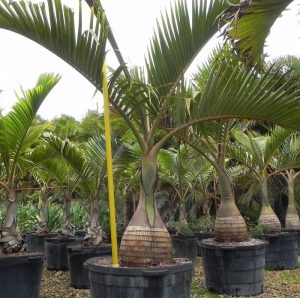Bottle Palm Tree
Not all people have a bottle palm tree on their property, but those who do can testify to its beauty. This beautiful plant’s name is inspired by its trunk’s strong resemblance to a bottle. Young bottle palm trees feature swollen and rounded trunks that become elongated as the plant matures. Native to the Mascarene Islands, the bottle palm tree thrives in warm and balmy temperatures and loose sandy soil. At Palmco, we do not recommend bottle palm trees for cold northern climates because this plant is not cold hardy.
Best Places to Grow Bottle Palm Trees
 These trees are extremely popular in Florida and other states because of their beautiful trunks that make a perfect silhouette in any garden or landscape. The slow-growing and drought-tolerant plant has minimal growth and maintenance requirements.
These trees are extremely popular in Florida and other states because of their beautiful trunks that make a perfect silhouette in any garden or landscape. The slow-growing and drought-tolerant plant has minimal growth and maintenance requirements.
These palms will do best in warm climates. They prefer USDA zones 10B-11 because they can be easily damaged by freezing temperatures. They are not cold tolerant, and you will see some damage to fronds when the temperatures hit 32 degrees Fahrenheit. Don’t touch the cold damaged fronds until after the winter is over in order to protect new growth. Once spring arrives, you can trim the damaged fronds.
Caring for Bottle Palms
An essential part of bottle palm tree care is frost protection, especially for people growing it in the northern climates. To protect your bottle tree palm from frost, tie up the fronds gently with an insulating material or light blanket as soon as the winter cold starts kicking in. Even a light frost can cause the fronds to wither and die.
Bottle palm trees require regular pruning because they are not self-cleaning. However, cutting off the dead leaves during summer when the weather is warm provides further plant insulation. In addition, add some potassium fertilizer to the ground to promote plant growth. Ideally, this should be done during early spring. In addition, watch for pests and diseases and combat the early signs as soon as you notice. For instance, yellowing of the leaves could indicate a nutrient deficiency or the early onset of leaf blight.
Bottle palm trees also require magnesium to thrive. Magnesium deficiency can be resolved quickly by adding a teaspoonful of Epson salt to the water and pouring the solution around the base of the plant. However, the best way to resolve nutrient deficiency in bottle palms is by using a complete palm fertilizer with the appropriate amounts of macro and micronutrients.
Although pruning is an essential part of bottle palm tree care, many gardeners rarely get to do this because the plant usually has four to ten leaves at a time. If you must prune the plant, wait for the leaves to become entirely brown before cutting them off.
Palmco is one of the leading growers of palm, mast, and bamboo trees in the U.S. We are premier growers of quality cold hardy mast and palm trees in our 600-acre plantation. Whether you are a contractor, landscape architect, or commercial developer, we have just the right tree for you.
Are you looking for a bottle palm tree for your landscaping project? Please contact Palmco today at (239) 283-1329 for a quote.

